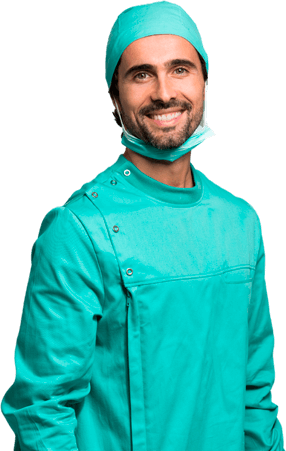
Single Jaw Orthognathic Surgery
in Madrid
- Hospital stay: 1 day
- Surgery time: 2 - 4 hours
- Anaesthesia: General
- Full recovery: 2 - 3 months


Hospital Viamed Santa Elena
Dr. Jesús Manuel Muñoz Caro
Calle La granja 8, 28003 Madrid
Fixed price
12.990 €
All included
Consult financing conditions
Financing is available* for amounts over €150, and can be financed from 3 and to 24 months. The financing process is subject to approval by the collaborating financial entities. For further information on the financing conditions, please do not hesitate to contact us at +34 91 141 33 56 or through this contact form. Our Patient Service department will provide you with the information you need and explain the financing process. Find additional information about funding in the following link. *Operarme’s team manages the funding of surgical procedures and medical tests. The financing management of dental services is only performed at Caser Dental Clinics.
What is included?
-
Free surgical consultation
Ask for a free, immediate surgical consultation with our specialist in Maxillofacial surgery.
Meet the doctor on a face-to-face consultation to assess your health problem, and then decide together your best options for surgical treatment.
-
Preoperative study
A complete pre-operative study will be performed: including a blood analysis, electrocardiogram and chest-X ray.
Also a consultation with the Anaesthetist will be held to see if you are suitable for the surgery.
-
Surgical procedure expenses and fees
- Reservation and booking of the operation room, instruments, equipment,consumables and medication of the surgical procedure.
- Medication (non cytostatic nor monoclonal antibody or derivatives), medical gases, Stay in the postoperative recovery room, monitorization and necesary treatments.
- Surgeon, assistant and anaesthetist fees until your medical discharge.
If there was any special need in the surgical process, by express indication of the doctor, the client will be informed of the variation in the price prior to surgery, and must be accepted to continue with the process.
-
Hospital stay
The hospital stay is for 1 day in a private room with a spare bed for your companion.
-
Transfer service
Leave your car at home while you stay at the hospital. A free transfer will be organized for your hospital admission day, and for your return home after hospital discharge. Service only available inside the metropolitan area.
Read the terms and conditions here.
If you woud like to receive more information about this service, please contact our patient service department.
-
Medical complications insurance
Single Jaw Orthognathic Surgery includes a medical complications insurance covering possible eventualities that may affect the patient during the surgical procedure, and 30 days after the surgical intervention (including a re-intervention if needed).
Medical complications insurance covers related surgical procedure expenses, such as:
- Increase in your hospital stay after surgery.
- Hospital admission after hospital discharge due to medical complications.
- Re-intervention and hospital stay up to the established amount established in the Particular Conditions.
Under no circumstances this insurance will cover emergency visits or medical review consultations after hospital discharge.
If you woud like to receive more information about this service, please contact our patient service department.
-
Post-surgical consultations
2 post-surgical consultations are included in the fixed price of this surgery.
If more consultations are necessary, they must be managed through Operarme's Patient Service team and paid at a preferential price. For more information or request additional consultation, contact our patient service team.
Post-surgical consultations NOT included in the closed price of the surgical process have a price of €39 per appointment.
What do our patients think?
Information of Single Jaw Orthognathic Surgery in Madrid
- All the information about single jaw orthognathic surgery in Madrid
- What is monomaxillary orthognathic surgery?
- Who is a candidate for single jaw orthognathic surgery?
- Assessment consultation with the Dr. Jesús Manuel Muñoz Caro
- Preoperative assessment for Single Jaw Orthognathic Surgery
- Single jaw orthognathic surgery: step-by-step
- Postoperative period at the Hospital Viamed Santa Elena
- Recovery time after single jaw orthognathic surgery
- Cost of single jaw orthognathic surgery with Operarme
-
All the information about single jaw orthognathic surgery in Madrid
As previously mentioned, at Operarme, the surgeries within the Speciality of Maxillofacial Surgery (single and double jaw orthognathic surgery, as well as genioplasty) are performed by the Dr. Jesús Manuel Muñoz Caro, one of the most highly regarded surgeons in the capital, at the Hospital Viamed Santa Elena in Madrid.
Throughout this page, we will explain step-by-step what the full process with Operarme entails — from the moment you request a free surgical assessment consultation with the Dr. Jesús Manuel Muñoz Caro to your complete recovery, typically 2–3 months later.
This is a major surgery, and while the recovery period may seem daunting at first, things become much more manageable after the first two weeks, and the results are usually excellent. It is rare for patients to be dissatisfied with the outcome.
The price listed on our website includes everything necessary to carry out the procedure in the safest and most thorough way possible (medical fees, prosthetic materials, hospital stay, use of the operating theatre, follow-up appointments, etc.).
The assessment consultation with the Dr. Jesús Manuel Muñoz Caro is completely free of charge.
The postoperative hospital stay generally ranges between 3 and 5 days.
Please note that the cost of the intervention does not include orthodontic treatment, if required, either before or after the surgery.
It also excludes any additional diagnostic tests requested by the specialist in order to plan or define the course of the surgery, as these are not necessary in all cases. Such tests may include orthopantomograms, 3D planning, or maxillary CT scans.
If you have any questions regarding this, please do not hesitate to contact our Patient Service team — we’ll be more than happy to help you.

Are you interested in jaw surgery?
Request a free assessment appointment with our specialists in Orthognathic surgery and set an intervention date for the treatment
Make appointment -
What is monomaxillary orthognathic surgery?
Orthognathic surgery aims to correct facial deformities caused by abnormal growth of the bones that make up the face — specifically, the jaw, upper maxilla, and chin. In the case of monomaxillary orthognathic surgery, only one of the two jaws (either the lower jaw or the upper maxilla) is operated on. In bimaxillary surgery, both are treated.
While these deformities understandably have an aesthetic component, they are often treated due to significant functional issues that impact your quality of life — such as jaw joint mobility problems, breathing difficulties, trouble swallowing, tooth loss, among others.
Orthognathic surgery is usually chosen when these issues cannot be resolved through conventional orthodontics. That said, in some cases (as explained later in the surgery-first protocol), orthodontics may be required before surgery to correctly align the teeth, and also after surgery to stabilize their final position.
Monomaxillary orthognathic surgery results in both aesthetic and functional improvement of the mouth.
All of this — and any questions you may have — will be explained in detail by the Dr. Jesús Manuel Muñoz Caro during your consultation. You can request a consultation by clicking on the button below:

Are you interested in jaw surgery?
Request a free assessment appointment with our specialists in Orthognathic surgery and set an intervention date for the treatment
Make appointment -
Who is a candidate for single jaw orthognathic surgery?
Single jaw orthognathic surgery is typically performed on individuals who, due to abnormal growth of the facial bones — including the jaw, maxilla, and chin — experience facial disharmony that impacts both their appearance and daily function.
The duration of single jaw orthognathic surgery ranges between 2 and 4 hours, depending on each case.
Before outlining the specific reasons for undergoing this procedure, it is worth noting that the recommended minimum age for surgery is around 19 for men and 16 or 17 for women. However, it is often advisable to wait until the age of 20 or 21 to ensure full skeletal development.
This type of surgery is also considered in cases where orthodontics alone is not a viable option due to the severity of the deformity.
The main reason for undergoing either single jaw or bimaxillary orthognathic surgery is the presence of a skeletal deformity that causes facial asymmetry and functional issues.
Although you likely already have an idea of the issue that has brought you to this page, we’ll now explain the different types of deformities that can be corrected through orthognathic surgery:
Mandibular retrognathia
Its correction is known as Class II orthognathic surgery. It occurs when the lower jaw has not developed in proportion to the rest of the facial structures, appearing small or set back, making it impossible for the teeth to align properly with the upper jaw.
This type of deformity, in addition to its aesthetic implications, can lead to issues such as temporomandibular joint (TMJ) disorders, snoring, obstructive sleep apnoea, voice alterations, swallowing difficulties, and dental problems caused by excessive strain during chewing.
The correction of this condition may be carried out through single jaw orthognathic surgery or chin surgery, depending on the specific case. However, in some situations, bimaxillary surgery may be necessary to achieve the best possible outcome.
Mandibular prognathism
Also known as Class III orthognathic surgery when referring to its correction, this condition occurs when the lower jaw is positioned forward in relation to the upper jaw,making it impossible to properly close the teeth. Mandibular prognathism is caused either by excessive growth of the lower jaw or by underdevelopment of the upper jaw.
In addition to aesthetic concerns—often giving the patient a more pronounced or coarse facial profile—this deformity can result in functional issues such as temporomandibular joint (TMJ) disorders, difficulties with swallowing or speech, and dental problems due to the extra effort required for chewing.
To correct this condition, either single jaw or bimaxillary surgery may be necessary, depending on the specific case. Orthodontic treatment is also typically required.
Open bite
An open bite can be caused by dental issues due to the incorrect positioning of the teeth, which can often be resolved with orthodontics, or by skeletal causes, involving abnormal growth of the facial bones that lead to this malocclusion.
While there are different types of open bite, the most common is the anterior open bite, where the upper and lower front teeth do not make contact. In adult patients or in more severe cases, which often have a skeletal origin, treatment must be combined orthodontics and orthognathic surgery.
Orthodontic treatment is required first to align the teeth and position them correctly to allow proper adjustment of the jaws and correction of the open bite.
Following this, orthognathic surgery is performed to reposition the upper jaw and the lower jaw, or just one of them, depending on the case (which is why a surgical assessment consultation with our specialist is important) to close the open bite and achieve the desired result. Finally, further orthodontic treatment will be necessary to stabilise the correction and make any final adjustments.
Facial asymmetry
Although no person has a perfectly symmetrical face, beauty is often associated with facial harmony, which is why individuals with pronounced asymmetry sometimes opt for orthognathic surgery to achieve an ideal appearance.
Facial asymmetry can result from skeletal imbalances, caused by excessive or deficient growth of the upper jaw or lower jaw; it can be generalised, due to imbalances anywhere on the face; or dental asymmetry, which requires correction of the teeth.
The solution for asymmetry depends on each case, but there are several options, including single-jaw or double-jaw orthognathic surgery, genioplasty (chin surgery) when the problem lies in the chin, angle prostheses, or angle surgery, either using silicone implants to reshape the area or performing osteotomy to restore facial symmetry.
Gummy smile
As you might imagine, a gummy smile refers to showing more gum than is considered normal when smiling. This issue is more aesthetic than functional and varies in severity depending on how much gum is visible.
It can be easily treated in some cases, while in others orthognathic surgery may be required:
- Mild gummy smile: This occurs when between 2 and 4 millimetres of gum is visible when smiling. This situation is often more of a perception issue for the patient rather than others, so a simpler solution may be possible.
- Moderate gummy smile: This is when 4 to 6 millimetres of gum is exposed, and it starts to be perceived as an aesthetic problem. In these cases, orthognathic surgery is not always necessary, but it will depend on the specialist’s evaluation during the consultation.
- Severe gummy smile: Considered severe when 6 millimetres or more of gum is shown when smiling. In these cases, orthognathic surgery is usually performed, typically single-jaw surgery if the case is not very complex, to shorten the length of the face.
How do I know if I need single- or double-jaw surgery?
To determine whether you need single-jaw (monomaxillary) orthognathic surgery, double-jaw (bimaxillary) surgery, genioplasty, or a combination of these procedures, it is best to attend a surgical assessment consultation with a Maxillofacial Surgery Specialist.
During this consultation, the surgeon will examine you, discuss your case, and if necessary, request specific diagnostic tests (such as panoramic X-rays, maxillary CT scans, bite splints, or 3D planning) to explain and decide which is the most suitable treatment option for your case.
Please note that these diagnostic tests are tailored to each individual and are not included in the price offered by Operarme nor the free surgical assessment consultation we offer; they must be paid for separately. If you have any questions about this process, feel free to contact our Patient Service Team here.
-
Assessment consultation with the Dr. Jesús Manuel Muñoz Caro
As we’ve aforementioned, the most important step before undergoing this type of procedure is the surgical assessment consultation with the Dr. Jesús Manuel Muñoz Caro. The specialist will evaluate your case based on your individual needs and advise you on the best option for your situation.
To request your consultation, you can do so via our website by clicking on Request Appointment, through our contact form, or by calling us directly on +34 91 141 33 56 — we’ll be happy to assist you.
Similarly, you can also request your consultation by clicking on the image below:

Are you interested in jaw surgery?
Request a free assessment appointment with our specialists in Orthognathic surgery and set an intervention date for the treatment
Make appointmentOnce your request has been submitted, you will receive all the information you need via email.
In addition, one of our Patient Service Advisors will get in touch with you to welcome you, confirm that the date and time of your appointment are suitable for you, and answer any questions or concerns you may have regarding the process.
On the day of the consultation, the specialist will listen to your concerns – for example, whether you are experiencing prognathism, retrognathia, a gummy smile, etc.
The specialist will then carry out a visual examination to confirm what you have described and will explain the best treatment option, whether it involves single jaw surgery, double jaw surgery, mentoplasty, or a combination.
the Dr. Jesús Manuel Muñoz Caro will explain what the surgery involves, how long it will take, what the recovery will be like, and exactly what will be done. The specialist will also answer all your questions and, in some cases, may request specific tests in order to accurately plan the procedure.
These tests may include: panoramic X-rays, maxillary CT scans, dental splints, or 3D surgical planning. The cost of these tests is not included in the price offered by Operarme, as they are not required in all cases.
You will need to pay for these tests directly at the hospital. Below is a brief explanation of what each one involves:
- 3D Planning: This allows your face to be analysed based on both functional and aesthetic concerns, taking your preferences into account and evaluating the features that may need to be altered. This type of planning is usually required in more complex cases.
- Panoramic X-rays: A type of X-ray that provides a full view of the teeth and the bones of both jaws.
- Maxillary CT scan: Produces a 3D image of the jaws and teeth.
After the consultation, if you and the Dr. Jesús Manuel Muñoz Caro decide to proceed with orthognathic surgery—whether single or double jaw—you may be able to agree on a date for the procedure with the surgeon.
In any case, our patient service team will contact you to assist with all the necessary arrangements and paperwork related to the surgery.
-
Preoperative assessment for Single Jaw Orthognathic Surgery
The preoperative stage for single jaw orthognathic surgery, as with other surgical procedures, includes three key tests:
- Electrocardiogram (ECG): This allows the medical team to assess your cardiovascular health and determine whether your heart is fit to withstand the procedure.
- Complete blood test: Blood analysis helps to confirm that the patient is in good general health and checks for any infections that may need to be treated before surgery.
- Chest X-ray: This is only carried out if the doctor deems it necessary. It helps to rule out any signs of infection and ensures that the trachea is correctly positioned.
Anaesthesia for single jaw orthognathic surgery
Single jaw orthognathic surgery is performed under general anaesthesia, as it is a major surgical procedure that typically lasts between 2 and 4 hours.
Therefore, prior to surgery, you will need to attend a consultation with the anaesthetist.
During this appointment, you’ll have the opportunity to ask any questions about the anaesthetic process. The anaesthetist will also review your preoperative test results and ask you several questions about your health, any previous surgeries, and your lifestyle habits. This may include whether you smoke, consume alcohol regularly, your diet, and any medications you take. This information helps ensure that the procedure can be carried out with the highest level of safety.
-
Single jaw orthognathic surgery: step-by-step
On the day of your surgery, you must go to the Hospital Viamed Santa Elena with the documentation your patient service advisor will have previously indicated.
Once there, at the admissions desk, you will identify yourself as an Operarme patient, hand in the required documents, and you will be taken either to your hospital room or to a waiting area, depending on the time of your scheduled surgery.
When the time comes, you will enter a pre-operative room where you will change clothes, put on the appropriate surgical gown, and a cannula will be placed in your arm to administer the anaesthetic and antibiotics.
You will then be taken to the operating theatre, where the Dr. Jesús Manuel Muñoz Caro, the anaesthetist you previously met, and several members of the surgical team will be waiting to assist with the procedure.
There, you will be asked to lie on the operating table, and the anaesthesia will be administered. Once the anaesthesia has taken effect, the surgery will begin. In this case, as it is a monomaxillary orthognathic procedure, only one of the two jawbones—either the upper jaw or the lower jaw—will be operated on, depending on your specific condition.
In both cases, the procedure is minimally invasive. The surgeon performs the correction through intraoral incisions, which helps to avoid visible scarring, reduce bleeding, swelling, and post-operative pain.
Below, we explain the two possible procedures involved in monomaxillary orthognathic surgery:
Upper jaw monomaxillary orthognathic surgery
- Firstly, the surgeon accesses the upper jaw by making an incision beneath the upper lip and above the gum, in the front area.
- Next, an osteotomy is performed to allow for mobilisation of the jaw, which is then repositioned correctly.
- Once in the desired position, the upper jaw is fixed in place using titanium miniplates and screws.
- After this step, the specialist closes the incisions with sutures, thus completing the procedure.
If the surgery were bimaxillary, or if the jaw being operated on was the lower jaw instead of the upper, the next step would involve surgery on the mandible, explained below:
Lower jaw monomaxillary orthognathic surgery
- The specialist begins by accessing the lower jaw through incisions made behind the last molar on both sides.
- A bilateral osteotomy is then performed using a micro-saw.
- Following this, the osteotomy is stabilised using miniplates and screws, just as with the upper jaw.
- Once the mandible is in the correct position, the incisions are sutured.
While the explanation may seem brief and straightforward, the surgery can last up to four hours in more complex cases.
As mentioned earlier, there are situations where the surgery first protocol may be applied, meaning that the surgery is performed before orthodontic treatment.
This is most commonly used in cases of mandibular prognathism. the Dr. Jesús Manuel Muñoz Caro will advise you on whether this approach is suitable in your case during your consultation.
Once the procedure is complete, you will be gradually woken in the operating theatre before being taken to the recovery room to finish recovering from the anaesthesia. You will then be taken to your hospital room.
-
Postoperative period at the Hospital Viamed Santa Elena
The hospital stay at the Hospital Viamed Santa Elena usually lasts just one day, and you can return home the following day.
During your stay, in addition to ensuring that everything has gone well, the medical team will explain how your recovery at home will proceed, when to return for your follow-up appointment, and you’ll be prescribed painkillers for pain management, among other instructions.
If you wish, don’t forget to request the transport service we offer at Operarme to take you home on the day of your hospital discharge.
Since speaking will be difficult—if not impossible—you can contact your patient service advisor via WhatsApp, or your companion can let us know when you're ready to be discharged.
-
Recovery time after single jaw orthognathic surgery
The first few days at home following surgery will be the most challenging, as you’ll need to adjust your daily routine. Don’t worry—most patients are extremely happy with the results.
First week
The main discomfort during recovery is having to follow a liquid diet, which must be consumed using a straw or syringes. Typical foods include soups, puréed meals, smoothies, and the like.
Additionally, it's normal to wear elastics throughout the day to help support the jaw.
You'll need to sleep in an upright position, as post-surgical swelling can make breathing more difficult.
As you’ll notice, you won’t be able to speak naturally at first.15 days after surgery
After the first two weeks, you should start noticing improvement, and you’ll move from a liquid diet to a soft food diet—eating foods like fish, scrambled eggs, and so on.
You’ll also only need to wear the elastics for a few hours a day, which makes everything more comfortable.As for physical activity, you may begin doing light exercise, provided it does not involve any risk of impact to the operated area—such as walking, jogging, or practising yoga. Still, avoid overexerting yourself.
Sick leave tends to last 2 to 3 weeks for office jobs that don’t require speaking or lifting. For more physically demanding jobs, or those that involve a lot of speaking or public interaction, recovery time may extend to 1 or 2 months—check with your specialist.One month after surgery
While recovery from single or double jaw orthognathic surgery varies from person to person, by the one-month mark, you should be able to lead a relatively normal life—except in terms of diet, which must remain soft for at least two months to avoid strain until the second month has passed.
Regarding contact sports, you’ll need to wait at least 3 months before resuming them. However, it’s always best to consult your specialist, who can advise you based on your specific case.
By the sixth month, recovery is considered complete, and you’ll be able to see the final results.
Advantages of orthognathic surgery with Operarme
In addition to the functional and aesthetic correction of the deformity—which is the main goal of orthognathic surgery—it is worth highlighting that the Dr. Jesús Manuel Muñoz Caro performs the surgery using a minimally invasive approach. This avoids visible scars and helps ensure a smoother postoperative period.
Furthermore, having your surgery with Operarme offers several advantages:
- All-inclusive fixed price: This means everything necessary to carry out your orthognathic surgery with the highest quality is included—medical fees, hospital stay, implantable prosthetic materials, anesthesia fees, preoperative tests, follow-up visits, a private room, and more.
- Transfer service: So you don’t have to worry about driving. If you wish, we’ll take you to the hospital on the day of admission and bring you home on the day of discharge, at no extra cost.
- Medical complications insurance: This insurance, included in all our inpatient surgeries, gives you peace of mind. If any unexpected issue arises that requires something additional—such as an extra night in the hospital—it will be covered without you having to pay more.
- Process management and personalized care: Throughout the entire process, you’ll have direct contact with your patient service advisor for any questions or arrangements. We’ll also coordinate your consultations, preoperative appointments, and admission dates—so all you have to focus on is getting better.
- Free surgical assessment consultation with no waiting: As mentioned throughout this text, you can meet the Dr. Jesús Manuel Muñoz Caro for a free consultation to assess your case at any time through Operarme.
- All-inclusive fixed price: This means everything necessary to carry out your orthognathic surgery with the highest quality is included—medical fees, hospital stay, implantable prosthetic materials, anesthesia fees, preoperative tests, follow-up visits, a private room, and more.
-
Cost of single jaw orthognathic surgery with Operarme
The cost of orthognathic surgery is 12.990 €.
Operarme includes everything necessary to perform the procedure with the highest guarantee of a successful outcome. The elements included in the price are designed not only to ensure safety, but also your comfort.
The following are included in the surgical package:
- Initial surgical assessment consultation
- Operating theatre reservation and use
- Complete preoperative tests
- Medical team fees
- Nursing team fees
- All necessary surgical materials
- Anaesthesia and recovery room booking
- Two postoperative check-ups
- Transfer service
- Medical Complications insurance
- Process management and personalised care
If you want to solve your jaw issue and book a free surgical assessment consultation, call us at +34 91 141 33 56, or click on the button below:

Are you interested in jaw surgery?
Request a free assessment appointment with our specialists in Orthognathic surgery and set an intervention date for the treatment
Fixed price
12.990 €
All included
Consult financing conditions
Financing is available* for amounts over €150, and can be financed from 3 and to 24 months. The financing process is subject to approval by the collaborating financial entities. For further information on the financing conditions, please do not hesitate to contact us at +34 91 141 33 56 or through this contact form. Our Patient Service department will provide you with the information you need and explain the financing process. Find additional information about funding in the following link. *Operarme’s team manages the funding of surgical procedures and medical tests. The financing management of dental services is only performed at Caser Dental Clinics.
Step by step
-
Ask for a free consultation with the Maxillofacial surgery team.
-
Information will be sent to your email.
-
Our patient service team will call you to confirm the date.
-
Visit the doctor and decide if you would like to have surgery with us.
-
Regain your quality of life.
What do our patients think?
Frequent Questions
-
Do I have to take a PCR test before surgery?
Currently our collaborating hospitals and surgeons do not ask patients to take a PCR test as a mandatory requirement to enter the operating room.
If exceptionally this test would be required by the hospital or surgeon, we inform you that the PCR test is not included in the price of the surgery.
If you have any questions about this specific issue, please contact our patient service department.

Single Jaw Orthognathic Surgery
- Hospital stay: 1 day
- Surgery time: 2 - 4 hours
- Anaesthesia: General
- Full recovery: 2 - 3 months


Hospital Viamed Santa Elena
Dr. Jesús Manuel Muñoz Caro
Calle La granja 8, 28003 Madrid
Fixed price
12.990 €
All included
Consult financing conditions
Financing is available* for amounts over €150, and can be financed from 3 and to 24 months. The financing process is subject to approval by the collaborating financial entities. For further information on the financing conditions, please do not hesitate to contact us at +34 91 141 33 56 or through this contact form. Our Patient Service department will provide you with the information you need and explain the financing process. Find additional information about funding in the following link. *Operarme’s team manages the funding of surgical procedures and medical tests. The financing management of dental services is only performed at Caser Dental Clinics.


